(AKC Terrier Group)
 The Parson Russell Terrier is a true working foxhunter, possessing a
ready attitude, alertness, confidence, and great strength and
endurance. Today, many Parsons are also found working in stables and
exhibiting at agility and obedience trials. The breed’s weatherproof
coat can be broken (wire-haired) or smooth and is white, white with
black or tan markings or tri-color.
The Parson Russell Terrier is a true working foxhunter, possessing a
ready attitude, alertness, confidence, and great strength and
endurance. Today, many Parsons are also found working in stables and
exhibiting at agility and obedience trials. The breed’s weatherproof
coat can be broken (wire-haired) or smooth and is white, white with
black or tan markings or tri-color.
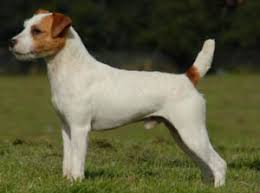 General Appearance
General Appearance
The Parson Russell Terrier was developed in the south of England in the 1800’s as a white terrier to work European red fox both above and below ground. The terrier was named for the Reverend John Russell, whose terriers trailed hounds and bolted foxes from dens so the hunt could ride on. To function as a working terrier, he must possess certain characteristics: a ready attitude, alert and confident; balance in height and length; medium in size and bone, suggesting strength and endurance. Important to breed type is a natural appearance: harsh, weatherproof coat with a compact construction and clean silhouette. The coat is broken or smooth. He has a small, flexible chest to enable him to pursue his quarry underground and sufficient length of leg to follow the hounds. Old scars and injuries, the result of honorable work or accident, should not be allowed to prejudice a terrier’s chance in the show ring, unless they interfere with movement or utility for work or breeding.
Size, Substance, Proportion
 Size: The ideal height of a mature dog is 14” at the highest point of
the shoulder blade, and bitches 13”. Terriers whose heights measure
either slightly larger or smaller than the ideal are not to be penalized in
the show ring provided other points of their conformation, especially balance,
are consistent with the working aspects of the standard. Larger dogs must
remain spannable and smaller dogs must continue to exhibit breed type and
sufficient bone to allow them to work successfully. The weight of a terrier
in hard working condition is usually between 13-17 lb. Proportion: Balance
is the keystone of the terrier’s anatomy. The chief points of consideration
are the relative proportions of skull and foreface, head and frame, height
at withers and length of body. The height at withers is slightly greater than
the distance from the withers to tail, i.e. by possibly 1 to 1 1/2 inches
on a 14 inch dog. The measurement will vary according to height. Substance:
The terrier is of medium bone, not so heavy as to appear coarse or so light
as to appear racy. The conformation of the whole frame is indicative of strength
and endurance. Disqualification: Height under 12” or over 15”.
Size: The ideal height of a mature dog is 14” at the highest point of
the shoulder blade, and bitches 13”. Terriers whose heights measure
either slightly larger or smaller than the ideal are not to be penalized in
the show ring provided other points of their conformation, especially balance,
are consistent with the working aspects of the standard. Larger dogs must
remain spannable and smaller dogs must continue to exhibit breed type and
sufficient bone to allow them to work successfully. The weight of a terrier
in hard working condition is usually between 13-17 lb. Proportion: Balance
is the keystone of the terrier’s anatomy. The chief points of consideration
are the relative proportions of skull and foreface, head and frame, height
at withers and length of body. The height at withers is slightly greater than
the distance from the withers to tail, i.e. by possibly 1 to 1 1/2 inches
on a 14 inch dog. The measurement will vary according to height. Substance:
The terrier is of medium bone, not so heavy as to appear coarse or so light
as to appear racy. The conformation of the whole frame is indicative of strength
and endurance. Disqualification: Height under 12” or over 15”.
Head
Head: Strong and in good proportion to the rest of the body, so the appearance of balance is maintained. Expression: Keen, direct, full of life and intelligence. Eyes: Almond shaped, dark in color, moderate in size, not protruding. Dark rims are desirable, however where the coat surrounding the eye is white, the eye rim may be pink. Ears: Small “V”- shaped drop ears of moderate thickness carried forward close to the head with the tip so as to cover the orifice and pointing toward the eye. Fold is level with the top of the skull or slightly above. When alert, ear tips do not extend below the corner of the eye. Skull: Flat with muzzle and back skull in parallel planes. Fairly broad between the ears, narrowing slightly to the eyes. The stop is well defined but not prominent. Muzzle: Length from nose to stop is slightly shorter than the distance from stop to occiput. Strong and rectangular, measuring in width approximately 2/3 that of the backskull between the ears. Jaws: Upper and lower are of fair and punishing strength. Nose: Must be black and fully pigmented. Bite: Teeth are large with complete dentition in a perfect scissors bite, i.e., upper teeth closely overlapping the lower teeth and teeth set square to the jaws. Faults: Snipey muzzle, weak or coarse head. Light or yellow eye, round eye. Hound ear, fleshy ear, rounded tips. Level bite, missing teeth. Four or more missing pre-molars, incisors or canines is a fault. Disqualifications: Prick ears. Liver color nose. Overshot, undershot or wry mouth.
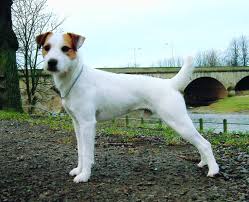 Neck, Topline, Body
Neck, Topline, Body
Neck: Clean and muscular, moderately arched, of fair length, gradually widening so as to blend well into the shoulders. Topline: Strong, straight, and level in motion, the loin of moderate length. Body: In overall length to height proportion, the dog appears approximately square and balanced. The back is neither short nor long. The back gives no appearance of slackness but is laterally flexible, so that he may turn around in an earth. Tuck-up is moderate. Chest: Narrow and of moderate depth, giving an athletic rather than heavily-chested appearance; must be flexible and compressible. The ribs are fairly well sprung, oval rather than round, not extending past the level of the elbow. Tail: Docked so the tip is approximately level to the skull. Set on not too high, but so that a level topline, with a very slight arch over the loin, is maintained. Carried gaily when in motion, but when baiting or at rest may be held level but not below the horizontal. Faults: Chest not spannable or shallow; barrel ribs. Tail set low or carried low to or over the back, i.e. squirrel tail.
Forequarters
Shoulders: Long and sloping, well laid back, cleanly cut at the withers. Point of shoulder sits in a plane behind the point of the prosternum. The shoulder blade and upper arm are of approximately the same length; forelegs are placed well under the dog. Elbows hang perpendicular to the body, working free of the sides. Legs are strong and straight with good bone. Joints turn neither in nor out. Pasterns firm and nearly straight. Feet: Round, cat-like, very compact, the pads thick and tough, the toes moderately arched pointing forward, turned neither in nor out. Fault: Hare feet.
Hindquarters
Strong and muscular, smoothly molded, with good angulation and bend of stifle. Hocks near the ground, parallel, and driving in action. Feet as in front.
Coat
Smooth and Broken: Whether smooth or broken, a double coat of good sheen, naturally harsh, close and dense, straight with no suggestion of kink. There is a clear outline with only a hint of eyebrows and beard if natural to the coat. No sculptured furnishings. The terrier is shown in his natural appearance not excessively groomed. Sculpturing is to be severely penalized. Faults: Soft, silky, woolly, or curly topcoat. Lacking undercoat. Excessive grooming and sculpturing.
 Color
Color
White, white with black or tan markings, or a combination of these, tri-color. Colors are clear. As long as the terrier is predominantly white, moderate body markings are not to be faulted. Grizzle is acceptable and should not be confused with brindle. Disqualification: Brindle markings.
Gait
Movement or action is the crucial test of conformation. A tireless ground covering trot displaying good reach in front with the hindquarters providing plenty of drive. Pasterns break lightly on forward motion with no hint of hackney-like action or goose-stepping. The action is straight in front and rear.
Disqualifications:
Height under 12” or over 15”.
Prick ears, liver nose.
Overshot, undershot or wry mouth.
Brindle markings.
Overt aggression toward another dog.
Approved: July 13, 2004
Effective: September 29, 2004
Eye conditions which affect the Parson Russell Terrier include primary lens luxation, a heritable condition. This disease causes the zonular fibres to be abnormal and begin to disintegrate in affected dogs. The fibres support the lens of the eye, and their destruction can cause the lens to fall into the wrong location within the eye. If the lens falls into the anterior chamber of eyeball then a secondary glaucoma can occur, causing loss of vision. National kennel associations such as the Kennel Club (UK) publish DNA screening results on Parson Russell Terriers, broken down into three groups; clears, carriers, and affecteds.
Other eye conditions which appear in the breed include cataracts in juveniles, corneal dystrophy, progressive retinal atrophy and posterior vitreous detachment. Non-eye breed related conditions which may affect a Parson are deafness and patella luxation. The average lifespan of a Parson Russell Terrier is between 14 to 15 years.

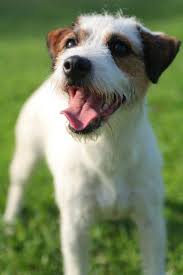
Bold and friendly. Athletic and clever. At work he is a game hunter, tenacious, courageous, and single minded. At home he is playful, exuberant and overwhelmingly affectionate. He is an independent and energetic terrier and requires his due portion of attention. He should not be quarrelsome. Shyness should not be confused with submissiveness. Submissiveness is not a fault. Sparring is not acceptable. Fault: Shyness. Disqualification: Overt aggression toward another dog.
Spanning: To measure a terrier’s chest, span from behind, raising only the front feet from the ground, and compress gently. Directly behind the elbows is the smaller, firm part of the chest. The central part is usually larger but should feel rather elastic. Span with hands tightly behind the elbows on the forward portion of the chest. The chest must be easily spanned by average size hands. Thumbs should meet at the spine and fingers should meet under the chest. This is a significant factor and a critical part of the judging process. The dog can not be correctly judged without this procedure.
The Parson Russell Terrier is a fox-hunting breed developed in
southern England nearly 200 years ago. As is true of many early white
fox terriers, he is in all likelihood the result of a cross between the
Old English White Terrier, now extinct, and a black-and-tan terrier
similar in type to the early Manchester.
The Parson Russell has been bred to possess several distinct characteristics: sound trotting gait and length of leg to follow the hounds, compact flexible chest and length of body to go to ground on fox, and strong head and muzzle and the will to hold the fox at bay.
Parson Russells were known in this country as early as the 1930s, and perhaps before. The Parson Russell is a terrier among terriers, buoyant and intelligent, determined and relentless. He is endowed with an inability to quit and no capacity to feel fear, regardless of the odds or consequences. Natural in attitude and appearance, he is tolerant of the show ring, hoping it is just the last stop before fox and field.
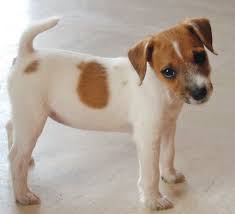
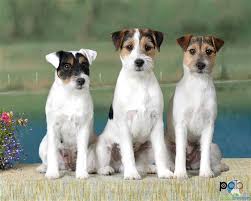
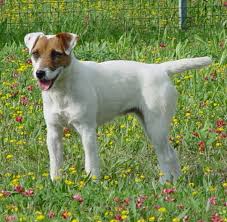
Parson Russell Terrier Breed Standards
The Parson Russell Terrier was developed in the south of England in the 1800’s as a white terrier to work European red fox both above and below ground. The terrier was named for the Reverend John Russell, whose terriers trailed hounds and bolted foxes from dens so the hunt could ride on. To function as a working terrier, he must possess certain characteristics: a ready attitude, alert and confident; balance in height and length; medium in size and bone, suggesting strength and endurance. Important to breed type is a natural appearance: harsh, weatherproof coat with a compact construction and clean silhouette. The coat is broken or smooth. He has a small, flexible chest to enable him to pursue his quarry underground and sufficient length of leg to follow the hounds. Old scars and injuries, the result of honorable work or accident, should not be allowed to prejudice a terrier’s chance in the show ring, unless they interfere with movement or utility for work or breeding.
Size, Substance, Proportion
 Size: The ideal height of a mature dog is 14” at the highest point of
the shoulder blade, and bitches 13”. Terriers whose heights measure
either slightly larger or smaller than the ideal are not to be penalized in
the show ring provided other points of their conformation, especially balance,
are consistent with the working aspects of the standard. Larger dogs must
remain spannable and smaller dogs must continue to exhibit breed type and
sufficient bone to allow them to work successfully. The weight of a terrier
in hard working condition is usually between 13-17 lb. Proportion: Balance
is the keystone of the terrier’s anatomy. The chief points of consideration
are the relative proportions of skull and foreface, head and frame, height
at withers and length of body. The height at withers is slightly greater than
the distance from the withers to tail, i.e. by possibly 1 to 1 1/2 inches
on a 14 inch dog. The measurement will vary according to height. Substance:
The terrier is of medium bone, not so heavy as to appear coarse or so light
as to appear racy. The conformation of the whole frame is indicative of strength
and endurance. Disqualification: Height under 12” or over 15”.
Size: The ideal height of a mature dog is 14” at the highest point of
the shoulder blade, and bitches 13”. Terriers whose heights measure
either slightly larger or smaller than the ideal are not to be penalized in
the show ring provided other points of their conformation, especially balance,
are consistent with the working aspects of the standard. Larger dogs must
remain spannable and smaller dogs must continue to exhibit breed type and
sufficient bone to allow them to work successfully. The weight of a terrier
in hard working condition is usually between 13-17 lb. Proportion: Balance
is the keystone of the terrier’s anatomy. The chief points of consideration
are the relative proportions of skull and foreface, head and frame, height
at withers and length of body. The height at withers is slightly greater than
the distance from the withers to tail, i.e. by possibly 1 to 1 1/2 inches
on a 14 inch dog. The measurement will vary according to height. Substance:
The terrier is of medium bone, not so heavy as to appear coarse or so light
as to appear racy. The conformation of the whole frame is indicative of strength
and endurance. Disqualification: Height under 12” or over 15”.Head
Head: Strong and in good proportion to the rest of the body, so the appearance of balance is maintained. Expression: Keen, direct, full of life and intelligence. Eyes: Almond shaped, dark in color, moderate in size, not protruding. Dark rims are desirable, however where the coat surrounding the eye is white, the eye rim may be pink. Ears: Small “V”- shaped drop ears of moderate thickness carried forward close to the head with the tip so as to cover the orifice and pointing toward the eye. Fold is level with the top of the skull or slightly above. When alert, ear tips do not extend below the corner of the eye. Skull: Flat with muzzle and back skull in parallel planes. Fairly broad between the ears, narrowing slightly to the eyes. The stop is well defined but not prominent. Muzzle: Length from nose to stop is slightly shorter than the distance from stop to occiput. Strong and rectangular, measuring in width approximately 2/3 that of the backskull between the ears. Jaws: Upper and lower are of fair and punishing strength. Nose: Must be black and fully pigmented. Bite: Teeth are large with complete dentition in a perfect scissors bite, i.e., upper teeth closely overlapping the lower teeth and teeth set square to the jaws. Faults: Snipey muzzle, weak or coarse head. Light or yellow eye, round eye. Hound ear, fleshy ear, rounded tips. Level bite, missing teeth. Four or more missing pre-molars, incisors or canines is a fault. Disqualifications: Prick ears. Liver color nose. Overshot, undershot or wry mouth.
Neck: Clean and muscular, moderately arched, of fair length, gradually widening so as to blend well into the shoulders. Topline: Strong, straight, and level in motion, the loin of moderate length. Body: In overall length to height proportion, the dog appears approximately square and balanced. The back is neither short nor long. The back gives no appearance of slackness but is laterally flexible, so that he may turn around in an earth. Tuck-up is moderate. Chest: Narrow and of moderate depth, giving an athletic rather than heavily-chested appearance; must be flexible and compressible. The ribs are fairly well sprung, oval rather than round, not extending past the level of the elbow. Tail: Docked so the tip is approximately level to the skull. Set on not too high, but so that a level topline, with a very slight arch over the loin, is maintained. Carried gaily when in motion, but when baiting or at rest may be held level but not below the horizontal. Faults: Chest not spannable or shallow; barrel ribs. Tail set low or carried low to or over the back, i.e. squirrel tail.
Forequarters
Shoulders: Long and sloping, well laid back, cleanly cut at the withers. Point of shoulder sits in a plane behind the point of the prosternum. The shoulder blade and upper arm are of approximately the same length; forelegs are placed well under the dog. Elbows hang perpendicular to the body, working free of the sides. Legs are strong and straight with good bone. Joints turn neither in nor out. Pasterns firm and nearly straight. Feet: Round, cat-like, very compact, the pads thick and tough, the toes moderately arched pointing forward, turned neither in nor out. Fault: Hare feet.
Hindquarters
Strong and muscular, smoothly molded, with good angulation and bend of stifle. Hocks near the ground, parallel, and driving in action. Feet as in front.
Coat
Smooth and Broken: Whether smooth or broken, a double coat of good sheen, naturally harsh, close and dense, straight with no suggestion of kink. There is a clear outline with only a hint of eyebrows and beard if natural to the coat. No sculptured furnishings. The terrier is shown in his natural appearance not excessively groomed. Sculpturing is to be severely penalized. Faults: Soft, silky, woolly, or curly topcoat. Lacking undercoat. Excessive grooming and sculpturing.
White, white with black or tan markings, or a combination of these, tri-color. Colors are clear. As long as the terrier is predominantly white, moderate body markings are not to be faulted. Grizzle is acceptable and should not be confused with brindle. Disqualification: Brindle markings.
Gait
Movement or action is the crucial test of conformation. A tireless ground covering trot displaying good reach in front with the hindquarters providing plenty of drive. Pasterns break lightly on forward motion with no hint of hackney-like action or goose-stepping. The action is straight in front and rear.
Disqualifications:
Height under 12” or over 15”.
Prick ears, liver nose.
Overshot, undershot or wry mouth.
Brindle markings.
Overt aggression toward another dog.
Approved: July 13, 2004
Effective: September 29, 2004
Parson Russell Terrier Health Issues
Eye conditions which affect the Parson Russell Terrier include primary lens luxation, a heritable condition. This disease causes the zonular fibres to be abnormal and begin to disintegrate in affected dogs. The fibres support the lens of the eye, and their destruction can cause the lens to fall into the wrong location within the eye. If the lens falls into the anterior chamber of eyeball then a secondary glaucoma can occur, causing loss of vision. National kennel associations such as the Kennel Club (UK) publish DNA screening results on Parson Russell Terriers, broken down into three groups; clears, carriers, and affecteds.
Other eye conditions which appear in the breed include cataracts in juveniles, corneal dystrophy, progressive retinal atrophy and posterior vitreous detachment. Non-eye breed related conditions which may affect a Parson are deafness and patella luxation. The average lifespan of a Parson Russell Terrier is between 14 to 15 years.
Parson Russell Terrier Temperament
Bold and friendly. Athletic and clever. At work he is a game hunter, tenacious, courageous, and single minded. At home he is playful, exuberant and overwhelmingly affectionate. He is an independent and energetic terrier and requires his due portion of attention. He should not be quarrelsome. Shyness should not be confused with submissiveness. Submissiveness is not a fault. Sparring is not acceptable. Fault: Shyness. Disqualification: Overt aggression toward another dog.
Spanning: To measure a terrier’s chest, span from behind, raising only the front feet from the ground, and compress gently. Directly behind the elbows is the smaller, firm part of the chest. The central part is usually larger but should feel rather elastic. Span with hands tightly behind the elbows on the forward portion of the chest. The chest must be easily spanned by average size hands. Thumbs should meet at the spine and fingers should meet under the chest. This is a significant factor and a critical part of the judging process. The dog can not be correctly judged without this procedure.
Did You Know?
- The Parson Russell Terrier is AKC's 145th breed.
- The Parson Russell Terrier was first bred in the south of England in the mid-1800's to hunt European red fox, both over and underground, for the sport of kings.
- The breed got its name from the most renowned of British huntsman, Reverend John Russell, "The Sporting Parson," whose passion for fox hunting, hounds, and working terriers is legendary.
- Arthur Heinemann, who founded the Parson Jack Russell Terrier Club in 1914, drafted the first Jack Russell breed standard in 1904.
- After John Russell's death, the name "Jack Russell" was misused to describe all mix and manner of working and hunt terriers, many of which bore little, if any, similarity to Russell's own terriers.
- To date, the Parson Jack Russell has been recognized under the F.C.I. umbrella by News in Germany, Norway, Finland, Sweden, Denmark, The Netherlands, Italy, South Africa, and Australia.
Parson Russell Terrier History
| John "Jack" Russell |
The Parson Russell has been bred to possess several distinct characteristics: sound trotting gait and length of leg to follow the hounds, compact flexible chest and length of body to go to ground on fox, and strong head and muzzle and the will to hold the fox at bay.
Parson Russells were known in this country as early as the 1930s, and perhaps before. The Parson Russell is a terrier among terriers, buoyant and intelligent, determined and relentless. He is endowed with an inability to quit and no capacity to feel fear, regardless of the odds or consequences. Natural in attitude and appearance, he is tolerant of the show ring, hoping it is just the last stop before fox and field.
Parson Russell Terrier Pics
AKC Registered Breeders
Parson Russell Terrier
Parent Club: Parson Russell Terrier Association of America
Breeder Referral: Jeanette Pinker; EST (610) 593-6185
Breeder Directory: website
Parent Club: Parson Russell Terrier Association of America
Breeder Referral: Jeanette Pinker; EST (610) 593-6185
Breeder Directory: website
No comments:
Post a Comment